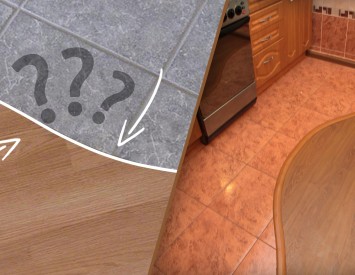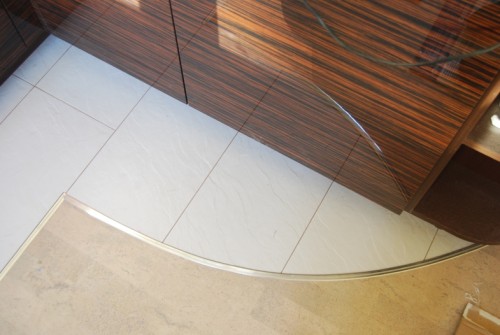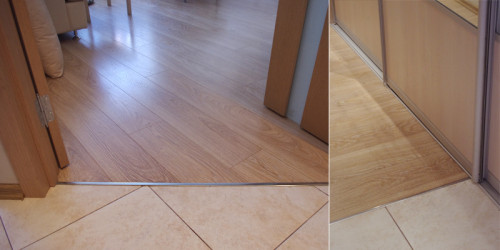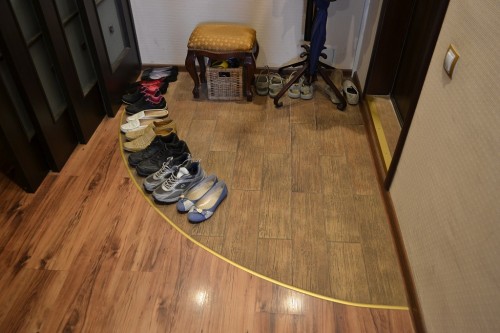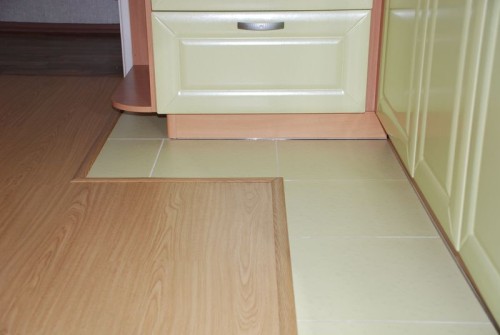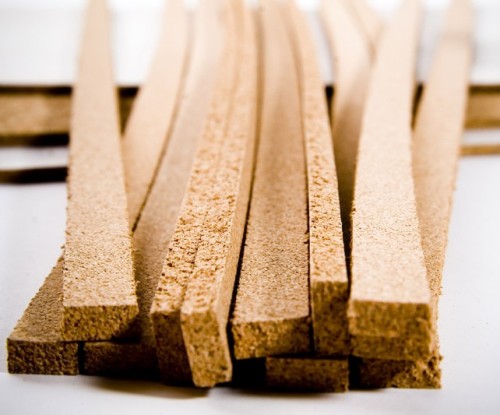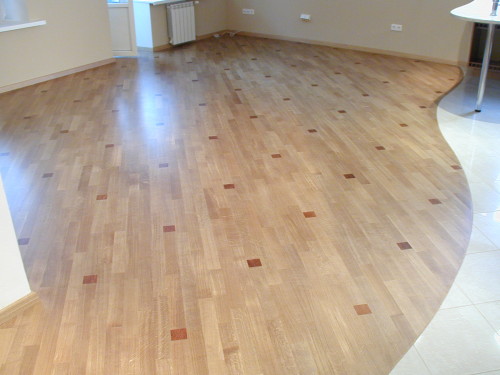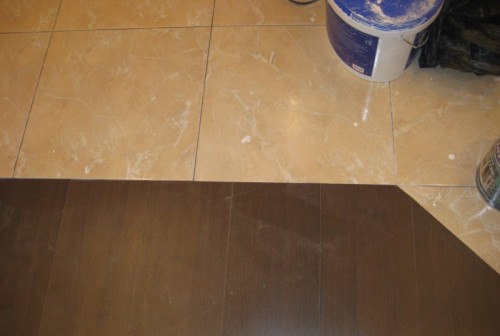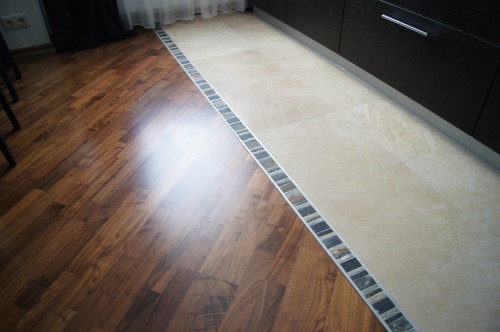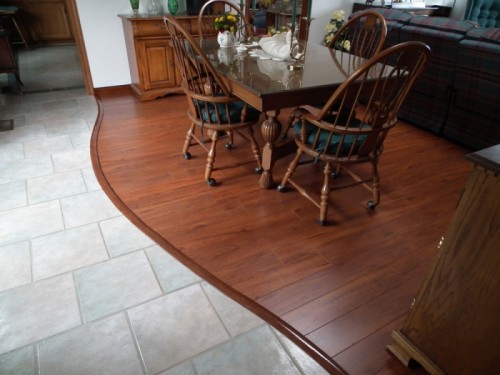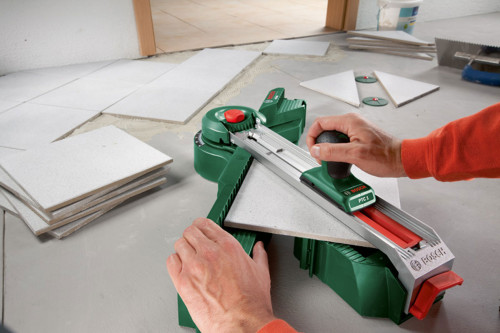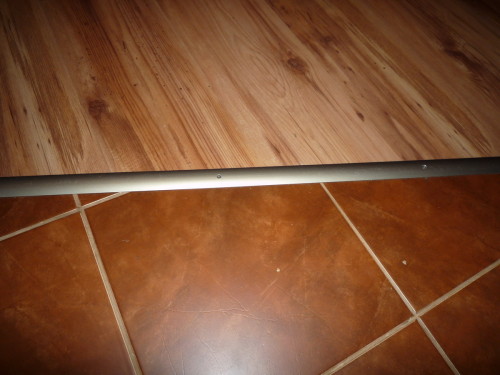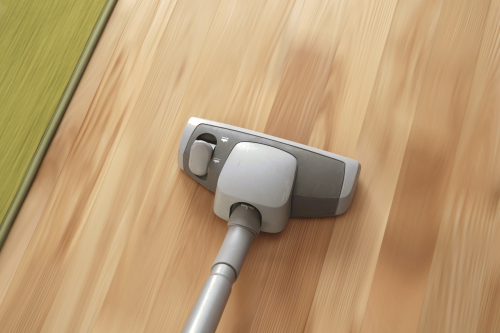Over the past years, the method of combining two finishing materials in one coating has gained considerable popularity. Such a design solution allows you to create an original design of the room and divide it into zones. One of the options is the connection of a laminate board with tiles. This will easily zone for various segments of space. In this article, we will consider the features of such a docking and methods of its implementation.
Content
Features of the design
The docking of coatings is often performed both in the living room and in the kitchen. However, the scope of technology is not limited to this. A fairly common option is the design of the space near the fireplace or balcony. This technique is also used for the arrangement of hallways. And near the front door, as a rule, a tile is laid, which is more resistant to moisture, and then laminating coating is located.
Tiles are recommended to allocate a space near the sink, stove, kitchen set, washing machine. This material has a high degree of strength, resistance to mechanical influences, moisture and high temperature. Tiles are easily cleaned of pollution, including fat. But it is not recommended to cover the entire surface of the floor, since walking on such a coating is inconvenient. This is a rather slippery and cold material. The laminate is more convenient in this regard. According to tactile sensations, it resembles natural wood, but it is tangibly cheaper. The appearance of the laminate board is preserved for a long period.
The following reasons for the combination of two types of coatings can be distinguished:
- zoning of space;
- visual increase in the room;
- economy. Tiles are more expensive than a laminate, so the use of two materials will help reduce repair costs;
- practicality. The use of tile coating will make it possible to protect places subject to mechanical loads.
The joint of the laminate and tiles. Photo:
Processing method
When combining coatings, the question will inevitably arise of how to make a joint between tiles and laminate. One of the design options is the use of spikes. They are divided into several types from the material from which they are made. These products are divided into:
- steel;
- aluminum;
- wooden;
- plastic parts.
Porks based on aluminum and steel have more profitable operational characteristics. They surpass products from other materials in strength and wear resistance. But it is advisable to use them only when working with metallized tiles.
For tiles and ceramics, wooden and plastic parts will be a more suitable choice. Wooden rapids are characterized by high aesthetic indicators. Plastic products can imitate various types of wood, but they are inferior in terms of strength of natural wood. For this reason, they should not be used in rooms with a large load. In order to most aesthetically arrange the joint of tiles and laminate, spikes should be chosen under the color of the coating.
Porks are also divided into species depending on the purpose. According to this criterion, they distinguish:
- leveling;
- straight;
- final elements.
Direct -type products are used in order to protect and decorate the clearance between coatings that are on the same level. The task of leveling details is to adjust the difference between coatings. Using the final elements, the edges of the catwalks are designed.
The docking is as follows:
- There should be a minimum gap between the finishing materials.
- The edges do not need processing, they will be closed with a vote.
- On the line of the clearance, openings are drilled through the punch or electrode.
- Further, with the help of plastic dowels, spikes are attached.
- Moldings can have a hidden mount. In this case, the lower bar is primarily installed, after which the rapids are fixed.
Drilling with traffic jams
The junction of tiles and laminate without breed can be decorated using a cork compensator. This product is very easy to use, because It just needs to be inserted into the gap. The advantage of such a cork is the absence of the need to leave a technological seam, since the compensator has the ability to increase and decrease in size by 5 mm.
But when using this product, tiles and laminate should be cut as smooth as possible. The cork only fills the space, but does not hide the edges of the flooring. Therefore, if the cutting is performed poorly, all defects will be visible.
Features of the use of sealing tools
For masking the gap, silicone sealant or mounting foam is also used. Today, there are sealants of various shades on sale, which will allow you to choose the remedy for the color of the coating. The sealing composition must have high elasticity in order to compensate for the difference in the physical properties of laminated boards and tiles.
The advantage of this method of designing joints is high strength and reliability. But the use of such funds also has the opposite side - the impossibility of repair work in the field of connection. In case of such need, you will have to dismantle the entire joint.
Invisible association
The almost invisible connection of the laminate and tiles is used for direct joints. The edges of the tile and boards should be perfectly chopped. A gap of 2-3 mm is left between the materials. It is impossible to do the docking, because This will provoke the destruction of the coating. Moreover, the finish can be damaged not only at the place of connection of the materials, but also at a distance of several meters. The mounting gap with a fugue for ceramics is filled. The disadvantage of this tool is poor adhesion with a laminated board, in the future the putty will have to be periodically updated.
Using mosaics
The junction of tiles and laminate can be masked using mosaics. To do this, you should perform actions in the following sequence:
- First, the space is filled with a cement mixture, PVA or composition, through which tiles were laid.
- Next, without waiting for the solution to dry, it is necessary to cover the surface with a mosaic.
- After which the gap should be wiped.
The use of mosaics will supplement the interior of the room and make a note of originality. If you choose the material under the color of the room, the mosaic strap will be a continuation of the common color composition.
Design of arched joints
The flexible joint between the tiles and the laminate is decorated using soft plastic or aluminum. Plastic is a T-shaped product consisting of two elements: a lock attached to the floor surface and a decorative flexible overhead material that is placed in this latch. This product bends well. The T-shaped lining is also used for insufficiently flat pruning.
The installation of a flexible profile is performed in the following order:
- There should be a space between the tiles and the laminate, which will allow you to fix the molding and leave a gap of 5 mm.
- Next, in the seam, a perforator needs to drill holes for dowels. If the seam passes on a warm floor, it is better to use liquid nails.
- Then it is necessary to cut off the required length of the molding and attach it using dowels to the base.
- When using a flexible decorative profile, it should initially be softened. To do this, the molding is placed in water with a temperature of up to 70 ° C for 20 minutes.
Aluminum is a mortgage part, which is mounted simultaneously with tiles. Unlike soft plastic, it cannot be used to hide uneven trimming. Aluminum is capable of blocking the material only by 2 mm. This part is sold in direct form, when using it you need to bend and give the necessary position. Work with aluminum requires a thorough approach and attentiveness. To install an aluminum spark, you need to cut the required length of the material and fix it in the seam area.
Tips for cutting laminate and tiles
Before you make the joint of the tiles and laminate, you should familiarize yourself with the rules for cutting the material:
- To cut the laminate board, a lot of effort is not required. This procedure is performed using an electric system or circular saw with small teeth. In the absence of these tools, a hacksaw for metal or manual saw is suitable.
- The material must be put on the hard surface by the outer side up. You need to cut the board carefully, otherwise chips are formed on it.
- Cut the tile will help a tool called "Teling cutter". But not everyone has it, so ordinary glass cutter can be used.
- It is necessary to carry out on the tile using an even object, for example, a ruler. The material is cut only 1 time. If you draw on the tile with glass cutter, the edges will turn out to be curved many times.
- Then the tile must be broken. To do this, a nail is placed under it and a sharp press is performed.
Dragging rules
The joint between the tiles and the laminate is recommended to be carried out on one plane. Theoretically laminated coating can be combined with a step, but in practice it will be inconvenient and can cause injuries. To achieve the necessary plane, you need to carefully prepare the base, and the floor screed must be flat. The thickness of the laminate and tiles is almost identical, the difference can be 1-2 mm. This difference is adjusted by a substrate for laminating coating.
In order for the connection area to have an aesthetic look, you need to perform an accurate trim of the material. The width of decorative linings is small, so with poor -quality cutting with their help it will not be possible to completely hide the joint. The space between the two types of coating should not exceed 10 mm. It is impossible to perform a docking without a gap. The laminate changes its size under the influence of temperature differences. If you do not leave the required distance, the coating will swell, and the seams will occur. Dugiform compounds require special attention.
Work should be done in the correct sequence. The tile is laid using an adhesive mixture or cement mortar, and for laminate, contact with moisture is undesirable. Therefore, it is necessary to initially lay the tile, wait for the composition to complete the composition and only then proceed to laying the laminate coating. This sequence is due to another nuance - the laminate is easier to cut, so it is easier to correct it than a tile.
Care recommendations
- Laminate care does not require much effort. To maintain a coating in clean condition, it is enough to perform weekly wet cleaning.
- In rooms with large cross -country ability, such as an entrance hall or a corridor, a solution of 4 liters of warm water and 2 tablespoons of shampoo can be used to cleanse.
- If the laminate has faded to correct the situation with the following tool. In the container, you need to connect 2 cups of water, 1 cup of lemon juice and 2 cups of vinegar. The resulting composition needs to wipe the coating.
- As a result of the movement of heavy objects on a laminate board, scratches can remain. You can get rid of them with the help of an ordinary eraser, which must be rubbed in a damaged place.
- Due to the regular use of cleaners on the surface of the laminate, a wax plaque can form. The composition of 1 cup of vinegar and 4 liters of water will help to eliminate it.
- Pollution on the tiles are removed using a solution of warm water and detergent. But for cleansing, you can not use hard and metal brushes, wipe the tile coating only with a soft policeman.
Conclusion
The combination of finishing materials will allow dividing the room into functional parts, diversify the interior and give it originality. But, before closing the joint of the laminate and tiles, the appropriate preparation needs to be carried out. The edges of the finishing material should be even, for this it is necessary to cut it in compliance with certain rules.
How to arrange a joint of tiles and laminate. Video:
